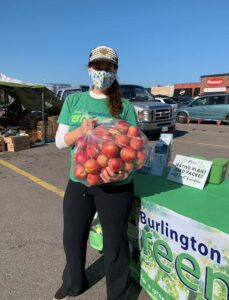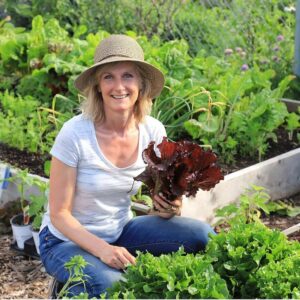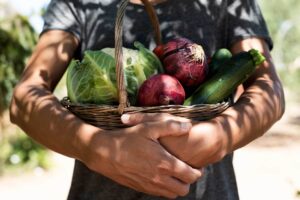
Thanks to the Government of Canada’s Emergency Community Support Fund and the Burlington Foundation, we responded to COVID-19 by pivoting and expanding our impactful Grow to Give program by gathering a whopping 829 lbs of fresh healthy produce from Burlington gardeners and community members, safely delivering it to local food bank agencies.
You can donate fresh produce to the Burlington Food Bank all year long. Find out more here.
The Grow to Give program began back in 2011 when BurlingtonGreen advocated to the City of Burlington to establish community gardens on public land. In 2012 the Central Park Community Garden was built by the City and operated by BurlingtonGreen for two years as a pilot project. The project was such a success that the city went on to create 4 additional community gardens, for a current total of 5 community gardens and 217 plots available on public land.
While the City took over garden management and operations, the Grow to Give Garden lived on at Central Park Community Garden where our amazing volunteers organized, planted and grew food for donation to local food security agencies such as Wellington Square United Church and the Burlington Food Bank. In addition, they organized hands-on workshops in the garden to learn about gardening and growing local food. We thank our volunteers immensely for their tireless efforts in the garden!

We continued to work actively in the garden in this capacity each year until 2020 when COVID-19 hit. We responded to COVID-19 by pivoting and expanding our impactful Grow to Give program by setting up Fresh Produce Donation Collection sites at 4 community gardens. These collection sites offered the opportunity for individuals with a community garden plot, as well as local gardeners in the community to drop off excess produce, which was donated to the Burlington Food Bank.
Over the last 8 years our Grow to Give program has donated nearly 9000 lbs of healthy fresh produce to local food security agencies supporting local families in need.
A HUGE shout out to our hardworking volunteers. We are grateful for all of the passion, support and knowledge you brought to the gardens – we couldn’t have done it without you!
We are so proud of what we have accomplished with Grow to Give. Inspiring, empowering and engaging the community to garden, grow local and support our local food security system. We are truly excited by the number of new and emerging community groups working in the realm of local food – we not only encourage it, but we support it!
In 2021 we are so excited to transition Grow to Give over to our friends at Grow A Row, who will be gardening and growing food at Central Park Community Garden and setting up fresh produce collection sites at Burlington community gardens. We look forward to this partnership in the upcoming growing season!

Community gardens are a wonderful place to hone your green thumb skills, spend time in nature, get exercise and meet members of your community. Growing food locally is not only good for us, but it’s good for the environment too!
Check out these fun and informative virtual tours of our community gardens, and some of the fantastic people you might expect to meet there!
- Central Park Community Garden Tour with Adria from Grow A Row
- Maple Park Community Garden Tour with Lisa from The Burlington Food Bank Garden
- Francis Road Bikeway Community Garden Tour with Michelle from the City of Burlington
- Ireland Parking Community Garden Tour with Local Gardener
- Amherst Park Community Garden Tour
To learn more about community gardens visit the City of Burlington for more information.
Whether it is joining a community garden, growing in your own home garden, balcony or container planting, this page is dedicated to highlighting the many opportunities, resources and tips to help you have a local green thumb.
Check out these fun and informative videos to get you gardening and growing local food!
- Growing Your Own Food, Eating Local and the Environment
- Closing your garden for the season
- Planting garlic in the fall
- Making Homemade Pasta Sauce
- Rewatch ‘Food Chats with Chantelle’ on Food Innovation, Supporting Young Farmers & Inspiring People to Grow Food
Types of Gardening:
- Kitchen Gardens (aka victory, backyard, or rooftop gardens)
- Container Gardens (aka balcony or rooftop gardens)
- Vertical Gardens – perpendicular hydroponic systems that maximize the use of space for growing a variety of beneficial plants. These unique growing systems come in three basic forms: tubes, coconut-cylinders or walls. All are designed to be easily moved indoors or outdoors as desired.
- Permaculture Landscaping – a practical design philosophy guided by its own set of ethics and aimed at creating sustainable living environments to meet human needs while treading lightly on the earth.
External Resources:
- Halton Food – local food resources
- Burlington Food Bank Garden – local food resources
- Free Garden Supply Planners – garden planning
- Food Share – garden planning and how-to guides
- Gardening Know How – garden planning and how-to guides
- Seed Savers Exchange
Local Seed Suppliers:
- William Dam Seeds – Dundas
- Seeds of Diversity – Kitchener
- Ontario Seed Company – Waterloo
“Local” or “locally grown” generally means that the products described originated within a limited number of kilometers of the place where they are sold, manufactured, processed, produced or packaged in close proximity to where it is sold. (Ontario Ministry of Agriculture, Farming and Rural Affairs).
means that the products described originated within a limited number of kilometers of the place where they are sold, manufactured, processed, produced or packaged in close proximity to where it is sold. (Ontario Ministry of Agriculture, Farming and Rural Affairs).
Supporting local food producers and urban agriculture is part of BurlingtonGreen’s mandate for a healthy, environmentally responsible city. So, why choose local?
Choosing local has a lasting impact on sustaining family farms, supporting our local rural and urban economies, encouraging agricultural diversity, and promoting sustainable environmental practices. It also secures a predictable and more stable food source for the future and provides a cushion against a vulnerable global food system.
On average, food travels about 2,500 kilometres before it reaches our plates. Alternatively it is quite possible to eat food grown, raised and processed that travels only 50-250 km. That food is a lot less dependent on the fossil fuels that negatively impact our environment.
Farmer’s markets are great places to hang out and discover local food. Markets are the most accessible way to introduce urban kids to where their food really comes from. They offer a chance for you to meet your local farmer and food producers, to ask them questions, to find out if they sell at their farm gate or in other retail locations. Use this opportunity to make a connection and get to know your area farmers.
Finding Local Food in Burlington:
- Halton Region – Local Agriculture
- Centro Market in downtown Burlington on Brant Street. Sundays starting in May.
- The Burlington Centre Lions Farmer’s Market on Wednesday, Friday and Saturday starting in May.
- Find more local food using the Greenbelt Fresh Market Directory Map.
Our society wastes a large amount of food each year, anywhere from 30% to 50%, depending upon the study. The waste is at all levels – farmers’ fields, distribution centres, supermarkets, restaurants and individual consumers.
Wasting food wastes energy, soil nutrients, farmland and the emissions from its production, which unnecessarily contributes to climate change. In addition, a significant amount of the food waste goes to landfill, rather than being composted, which further contributes to climate change through release of methane gas.
Food Waste Reduction Tips:
- Spread the word! Talk to family, friends, acquaintances about the issue of food waste.
- Make a conscious effort to only buy food that you know you will eat. Strive to eat all food before it goes bad – a bin in your fridge labelled “Eat first” can help.
- Store leftovers well so they can be eaten before going bad.
- Store food in visible locations so you’ll remember to use it before it goes bad. Food stashed away in the back of drawers, the fridge or cupboards can be forgotten about – keep them more visible (or post a reminder on your fridge door).
- Buy the ‘ugly’ or reduced produce when shopping. Cut off any bad sections. Reduced produce is still great for eating, can be used in fun ways like making banana bread or stir fry, and it’s often half price too!
- If you work in the food service industry, get in touch with a local food bank that may be willing to take your surplus items. Strive to avoid preparing too much food that won’t sell.
- If you host a party or event, try to avoid purchasing too much extra food. Only put out on the table what is needed at the time. Keep extra perishables refrigerated until needed so they don’t go bad if not eaten, so you can eat them the next day or give them away. Have a plan to get rid of any extra food – avoid throwing it out! Ask people to take extras home with them. Perhaps a neighbour or a local group you know would appreciate a food gift, as long it is still good and has been stored properly – it’s always a nice surprise to receive free food!
- And, if you have no choice but to throw it out, please remember to compost it in the green cart or backyard composter. Food waste sent to landfill in your garbage decomposes to produce methane gas, which contributes to climate change. On the other hand, compost can be used as a natural fertilizer and reduces dependency on petro-chemical based fertilizers.
- Rewatch ‘Food Chats with Chantelle’ on Food Waste & Mindful Consumption
Visit our Live Green page for more tips and resources to live gently on the planet.
Additional Food Waste Resources:
Visit our Live Green page for more tips and resources to live gently on the planet.

